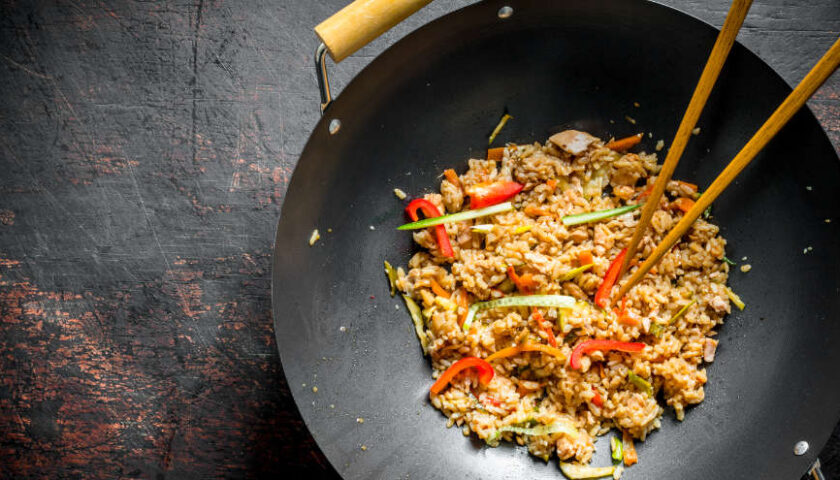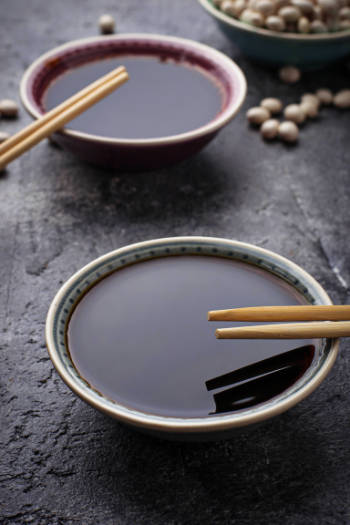
The Fascinating World of Fried Rice
Fried rice, a staple in Asian cuisine, has transcended its regional origins to become a beloved dish worldwide. Its versatility and ease of preparation have made it a favorite in households and restaurants alike. But what makes this simple dish so universally appealing?
The Origins and Evolution of Fried Rice
Fried rice, with its humble beginnings in China, is more than just a dish—it’s a story of culinary adaptation and cultural fusion. The genesis of fried rice is often traced back to the Sui Dynasty (581-618 CE) in China. In its earliest form, it was a simple, pragmatic solution to avoid wasting leftover rice.
The process of stir-frying rice in a wok, a common cooking utensil in Chinese kitchens, not only reheated the rice but also imparted a distinct flavor, especially when combined with bits of meat, vegetables, and sauces.
Over the centuries, as Chinese cuisine spread across the globe, fried rice evolved, absorbing local flavors and ingredients. This evolution resulted in an array of regional variations that mirror the diversity of culinary practices and cultural preferences.
- Chinese Variations: In China itself, there are numerous regional styles of fried rice. For instance, Yangzhou fried rice from Jiangsu province is famous for its generous use of ingredients like shrimp, peas, and eggs, offering a colorful and flavorful dish. Cantonese fried rice, on the other hand, is known for its delicate flavor, often incorporating seafood and a light seasoning to preserve the original tastes of the ingredients.
- Southeast Asian Influences: As fried rice traveled to Southeast Asia, it took on vibrant local flavors. Thai fried rice, for instance, stands out with its use of fragrant jasmine rice and the inclusion of ingredients like basil, lime, and spicy chilies, reflecting the bold flavors of Thai cuisine. Indonesian and Malaysian nasi goreng is another popular variant, distinguished by its aromatic and spicy profile, often featuring kecap manis (a sweet soy sauce) and a variety of meats and seafood.
- Japanese Adaptation: In Japan, fried rice, known as ‘chahan’, incorporates ingredients like sushi rice, which is stickier than the long-grain varieties typically used in other regions. Japanese fried rice often features a mix of local vegetables, eggs, and sometimes seafood, flavored subtly with soy sauce or oyster sauce.
- Indian and Nepalese Versions: In South Asia, fried rice takes a distinctly local turn. Indian fried rice varieties often include a blend of aromatic spices like cumin, garam masala, and turmeric, making them quite distinct from their East Asian counterparts. Nepalese fried rice, known as ‘bhuteko bhat’, often includes a mix of local spices and ingredients like green peas, carrots, and sometimes paneer (a type of cheese).
- Western Adaptations: In the West, fried rice has been adapted to suit local tastes, often featuring ingredients not typically found in Asian cuisine, such as broccoli, bell peppers, and a variety of protein sources like chicken, beef, and tofu.
In every region, fried rice is not just a reflection of local ingredients and tastes but also a symbol of the adaptability and creativity inherent in culinary practices. It embodies how a simple, economical dish can traverse boundaries, adapt to new environments, and become a beloved staple in diverse cultures around the world.
 The Art of Crafting the Perfect Dish
The Art of Crafting the Perfect Dish
The secret to exceptional fried rice lies in its preparation and ingredients. The choice of rice is crucial – typically, day-old, chilled rice ensures the grains remain separate and firm.
The high heat of a wok or skillet, coupled with swift stirring, gives the dish its signature texture and flavor.
Key Ingredients and Techniques
• Rice: The foundation of the dish, often leftover, chilled rice is preferred.
• Proteins and Vegetables: Commonly used ingredients include eggs, chicken, shrimp, carrots, and peas.
• Seasonings: Soy sauce, sesame oil, and sometimes oyster sauce, add depth and umami.
Tips for Perfect Results
• Cold Rice: Use rice that has been refrigerated to prevent stickiness.
• High Heat Cooking: Ensures a crispy texture and prevents sogginess.
• Balanced Flavors: A combination of savory soy sauce and aromatic sesame oil is key.
Nutritional Aspects and Dietary Adaptations
While traditional fried rice is a hearty dish, it can be adapted to suit various dietary needs. For those looking for healthier versions, brown rice or quinoa can replace white rice, and additional vegetables can increase its nutritional value.
For more on the nutritional aspects of fried rice, Healthline offers insights into the Nutritional Benefits of Fried Rice.
FAQs About Fried Rice
• Best Rice for Fried Rice: Day-old, long-grain rice like Jasmine or Basmati is ideal.
• Making in Advance: Yes, it can be prepared ahead and reheated.
• Enhancing Flavor: Use a combination of soy sauce, sesame oil, and fresh ingredients.
• Common Mistakes: Using freshly cooked rice or overcrowding the pan.
• Quick Recipes: There are many simple recipes that can be prepared in under 30 minutes.
• Healthier Versions: Opt for brown rice and increase the vegetable content.
• Freezing Fried Rice: It can be frozen and reheated, though fresh is best.
Innovative Twists and Fusion Recipes
The beauty of fried rice lies in its adaptability. Chefs and home cooks alike have infused it with ingredients from various cuisines, creating fusion dishes that are both innovative and delightful.
From the addition of kimchi for a Korean twist to the incorporation of curry spices for an Indian flair, these innovations keep the dish exciting and globally relevant.
Dietary Adaptations for Everyone
Fried rice is not just for those who consume a standard diet. It can be easily modified to cater to gluten-free, vegan, or low-carb preferences. For instance, tamari can replace soy sauce for a gluten-free version, while tofu can be a great protein substitute for vegans.
Cooking in Different Appliances
While traditionally cooked in a wok, fried rice can also be prepared in various modern appliances like non-stick skillets or even rice cookers. Each method offers a different texture and flavor profile to the dish, proving that fried rice can be tailored to suit any cooking style or equipment.
Presentation and Garnishing
The final touch to a perfect plate of fried rice is in its presentation. Garnishes such as sliced green onions, sesame seeds, or a wedge of lime not only enhance the dish’s flavor but also its visual appeal. Serving it in a unique bowl or alongside complementary dishes can turn a simple meal into a feast for the senses.
Best Fried Rice in Ann Arbor
When it comes to finding the best fried rice in Ann Arbor, one name consistently rises to the top: Lucky Kitchen. This beloved local eatery has not only carved out a reputation for serving some of the most flavorful and authentic fried rice in the area, but it has also become a culinary landmark in its own right.
Nestled in the bustling heart of Ann Arbor, Lucky Kitchen has established itself as a go-to spot for both locals and visitors, drawing in crowds with its enticing aromas and the promise of a truly satisfying meal.
At Lucky Kitchen, the fried rice is more than just a dish; it’s a celebration of flavors and techniques honed over years. The chefs take immense pride in their craft, using only the freshest ingredients, which is evident in every bite of their perfectly cooked rice.
The rice grains are fluffy and distinct, each carrying the rich flavors of the seasonings and fresh produce used. Whether it’s the vibrant colors of the vegetables or the perfectly cooked proteins that accompany the rice, every element in their fried rice comes together to create a harmonious and mouth-watering dish.
What sets them apart in the Ann Arbor food scene is their ability to maintain consistency in quality and taste. Regular patrons often rave about the reliability of experiencing the same delightful taste in every visit, a testament to the restaurant’s commitment to culinary excellence.
This consistency is paired with a warm and inviting atmosphere, making every dining experience memorable.
Lucky Kitchen: A Culinary Haven
With its cozy ambiance and friendly service, offers a variety of fried rice dishes that cater to a wide range of tastes. Whether you’re a fan of the classic egg fried rice or looking for something more adventurous like spicy shrimp fried rice, they have it all.
Their secret lies in using fresh, high-quality ingredients and traditional cooking methods that bring out the rich flavors and textures of the dish.
Why Lucky Kitchen Stands Out in Ann Arbor
In a city like Ann Arbor, known for its diverse culinary attributes, LK holds its own with its exceptional fried rice. What sets them apart is their commitment to authenticity and flavor.
Each dish is prepared with meticulous care, ensuring that every bite is a delightful experience. Their fried rice is not just a dish; it’s a reflection of their passion for Asian cuisine.
The Must-Try Fried Rice Dishes at LK
• Classic Chicken Fried Rice: A perfect blend of tender chicken pieces, fresh vegetables, and aromatic rice.
• Vegetable Fried Rice: A colorful and nutritious option for vegetarians, packed with a variety of fresh veggies.
• Spicy Shrimp Fried Rice: For those who like a bit of heat, this dish combines juicy shrimp with a spicy kick.
Conclusion
In essence, fried rice is a testament to culinary diversity and creativity. Its simple base evolves into a myriad of forms, each telling a story of cultural fusion and personal taste. Whether you’re enjoying a classic version or experimenting with new ingredients, fried rice offers a delicious journey through the world of flavors.
So, embrace your culinary curiosity and let fried rice be your guide to a world of endless possibilities in the kitchen.
